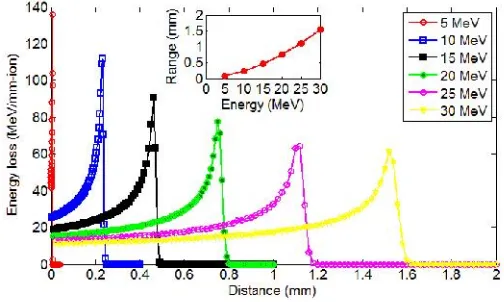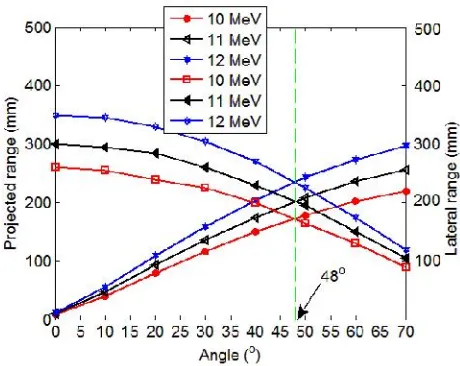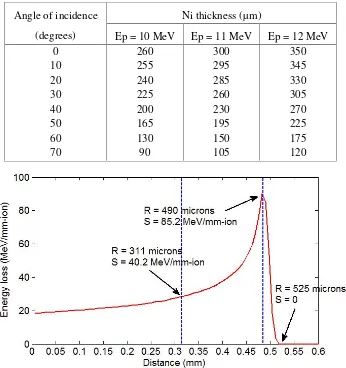THE STOPPING POWER AND RANGE OF ENERGETIC PROTON BEAMS IN NICKEL
TARGET RELEVANT FOR COPPER-64 PRODUCTION
Imam Kambali, Hari Suryanto and Herlan Setiawan
Center for Radioisotopes and Radiopharmaceuticals Technology (PTRR), BATAN Kawasan Puspiptek Serpong, Tangerang Selatan, Indonesia
Email: [email protected]
ABSTRACT
THE STOPPING POWER AND RANGE OF ENERGETIC PROTON BEAMS IN NICKEL TARGET RELEVANT FOR COPPER-64 PRODUCTION. The energy loss distribution of a range of energetic proton beams in nickel (Ni) target has been simulated using the Stopping and Range of Ion in Matter (SRIM 2013) codes. The calculated data of the proton’s range would then be used todetermine the optimum thickness of Ni target for future production of64Cu radioisotope. In general, the stopping power and range of proton beam in Ni depend strongly on the proton energy and incidence angle. It was also found that for an incidence angle of 0o with respect to the target normal, the best thickness of a Ni target should be between 260 – 350 µm for proton energy between 10 – 12 MeV. Furthermore, the thickness should be decreased with increasing incidence angle for optimum 64Cu radioactivity yield. The case study on the production of 64Cu by a 15.5-MeV proton bombardment indicated that the lower-than-expected yield was most likely due to a thinner Ni target than it should have been.
Keywords:stopping power, range, proton beam, Ni target,64Cu production
ABSTRAK
KAJIAN TERHADAP DAYA HENTI DAN JANGKAUAN PROTON DI DALAM TARGET
NICKEL DAN RELEVANSINYA UNTUK PRODUKSI RADIOISOTOP TEMBAGA-64. Distribusi
energi yang hilang dari sejumlah berkas proton berenergi tinggi telah disimulasikan menggunakan program
Stopping and Range of Ion in Matter (SRIM 2013). Hasil data perhitungan jangkauan proton tersebut selanjutnya akan digunakan untuk menentukan ketebalan optimum target Ni untuk produksi radioisotop64Cu di masa yang akan datang. Secara umum, daya henti dan jangkauan proton sangat tergantung pada energy dan sudut datang berkas proton. Untuk sudut datang 0o (tegak lurus terhadap permukaan target), ketebalan optimum target nikel direkomendasikan sebesar 260– 350 µm jika target tersebut diiradiasi dengan berkas proton berenergi antara 10–12 MeV. Selain itu, ketebalan tersebut hendaknya dikurangi jika berkas proton ditembakkan dengan sudut yang lebih besar dari 0o untuk optimasi hasil radioaktivitas 64Cu. Studi kasus terhadap produksi 64Cu dengan proton berenergi 15,5 MeV menunjukkan bahwa hasil radioaktivitas yang lebih rendah dari perhitungan teori kemungkinan besar disebabkan oleh target Ni yang terlalu tipis.
INTRODUCTION
Cyclotron-produced radionuclides such as
18
F, 123I and 11C have been widely used and
developed for Positron Emission Tomography (PET)
in domestic [1] and overseas hospitals [2,3], whereas
an intermediate-lived radionuclide such as 64Cu is
still under developing as potential radiotherapy
reagents [4,5]. Copper-64 can be produced in a
cyclotron by accelerating a proton beam up to a
certain energy level before being irradiated into a
highly-enriched 64Ni target via a nuclear reaction
64
Ni(p,n)64Cu. The resulting 64Cu radioisotope has a
half-life of 12.7 hours and emission characteristics
of β- (38%), β+ (19%) and Electron Capture (43%)
[6]. However generating 64Cu at a desired level of
radioactivity is not an easy task since the
radioactivity yield depends strongly on the Ni target
thickness, cross sections of the nuclear reaction and
some other technical parameters [7]. In addition, the
nuclear cross section is also dependent of the proton
beam energy as shown inFig. 1, which indicates that
the optimum proton energy for the 64Ni(p,n) 64Cu
nuclear reaction is around 10–11 MeV [8,9].
Fig. 1TALYS-Calculated excitation function of
64
Ni(p,n)64Cu nuclear reaction [8].
Another important parameter relevant to the
64
Cu production is the target thickness as it
corresponds to the radioactivity yield. Knowledge
about proton distributions in the Ni target is,
therefore, paramount to successfully determine the
correct target thickness prior to proton irradiation.
The proton distributions in Ni target can be
examined from the particle’s stopping power/energy
loss and range, which can be calculated using
Stopping and Range of Ion in Matter (SRIM)
package [10]. In the SRIM codes, stopping power is
defined as the energy required to slowing down the
incident particle during its interaction with matter
over a certain distance, and is mathematically
expressed as [11]:
speed of the incident particle to the speed of light, I
= average excitation energy of the target.
After losing energy and reaching a
maximum stopping power (called Bragg peak) due
to nuclear and electronic interactions, the incident
ion will eventually stop at a certain distance from the
target surface and leave some vacancies in the target.
The distance over which the ion totally stops is
called the projected rangeR(E), which satisfies [11]:
( ) = ∫ ……… (2)
Paul [12] has recently compared the
stopping power of some experimental data to the
SRIM-calculated results and to a few other available
software for a number of incident ions ranging from
hydrogen to uranium. Moreover, in most cases he
used SRIM package to calculate the range of several
proton beams in pure water relevant for 18F
production.
This paper reports on the use of the SRIM codes to
discuss the stopping power and range of proton in Ni
target and employ the calculated data to determine
the optimum thickness of the Ni target for 64Cu
radioisotope production. The dependence of the
range, and hence, the optimum target thickness on
the proton beam incidence angle are also examined.
In addition, a case study on the effect of setting up
an incorrect thickness of Nickel target to the 64Cu
radioactivity yield is also presented.
THEORETICAL CALCULATIONS
The theoretical calculations of the stopping
power and range of several energetic proton beams
of up to 30 MeV in Ni target (99.99%-enriched64Ni)
were carried out using the SRIM 2013 version
codes. For some expected proton energy (10, 11 and
12 MeV) for optimum64Cu radioisotope production,
the angle of incidence was also varied from θ = 0oto
θ = 70o with respect to the Ni target normal (as
defined inFig. 2).
Fig. 2Proton beam and Ni target set-up in the SRIM
calculations
In every investigated proton energy, there were
nearly 100,000 protons simulated in the calculations.
As well, a 15.5 MeV proton beam was simulated for
the purpose of a case study based on a paper written
by McCarthy, et al [14] to explain why they
obtained much lower64Cu radioactivity yield in their
experiments than they had expected in the theory.
RESULTS AND DISCUSSION
Stopping Power and Range of Energetic Proton
Beams in Ni Target
An example of the longitudinal and lateral
distributions of a 5-MeV proton beam bombarded
into a 100-µm thick Ni target can be seen inFig. 3,
in which around 99.9% of the incident proton hit the
target and stop after passing through a distance of
nearly 80 µm. Around 0.1% of the incident proton is
scattered off the target atoms at an angle of less than
90o, but there are no backscattered ions observed in
the simulation.
The behavior of the proton beam
distributions in the energy range between 5 MeV
and 30 MeV is relatively similar which can be
inferred from the shape of their energy loss/stopping
power plots (Fig. 4). In general, for any proton
energy, the stopping power increases with increasing
distance of travel until it peaks at a certain value
(called Bragg peak) and then drops dramatically
following the loss of the proton energy. In contrast
to the general trend of the energy loss, in which it
decreases with increasing proton energy, the range
increases with increasing proton energy as shown in
Fig. 3Trajectories of a 5-MeV proton beam in nickel target calculated using the SRIM 2013 version package
[10], depicted from longitudinal (left) and transversal (right) views .
Fig. 4Energy loss of several energetic proton beams ranging from 5 MeV to 30 MeV in nickel target, calculated using the SRIM 2013 version package [10]. The corresponding ranges are shown in the inset.
Angle Dependence of Proton Range
The following section discusses the
dependence of the proton range on the incidence
angle for proton energy of 10, 11 and 12 MeV. The
3 energy regimes were chosen in conjunction with
the optimum cross-section for 64Ni(p,n)64Cu nuclear
reaction (see Fig. 1). For a beam of 10-MeV
protons, the larger the incidence angle the shorter the
distance it travels, which is due to higher stopping
power as depicted in Fig. 5. In other words, the
range of the proton is shorter as the incidence angle
increases (inset, Fig. 5). It is also clear that the
distribution of the energy loss broadens with
Fig. 5Stopping power and range (inset) of a 10-MeV proton beam in Ni target at various angles of incidence
The behavior of the stopping power, range
and ion distribution is relatively similar for the two
other proton energy (11 MeV and 12 MeV)
investigated in this study. Again, the projected range
of the three simulated proton energy drop when the
proton incidence angles increase, whereas, in
contrast, the lateral range is larger with bigger angle
(Fig. 6). Furthermore, at an incidence angle of 48o,
for all proton energy, the projected range reaches
exactly the same value as their respective lateral
range. Increasing the incidence angle further will
result in longer lateral range as compared to the
projected range.
Recommended Ni Thickness for Optimum 64Cu
Production
As discussed elsewhere, Nickel target can be made
by electroplating technique [14-16], or prepared as a
foil target [17] and possibly by plasma deposition.
Regardless of the methods used for the Ni target
preparation, it is important to know the best
thickness for optimum 64Cu radioactivity yield.
Based on the SRIM calculations, the recommended
thickness of Ni target appropriate for the PET
radioisotope production is summarized in Table 1.
Note that the recommended thicknesses were
derived from the calculated range of proton beams at
10, 11 and 12 MeV, plus a 10% increase from their
original values to compensate deviation which
maybe encountered experimentally.
Fig. 6Ranges of 10-12 MeV proton beams in Ni
Table 1Recommended thicknesses of Nickel targets for 3 different proton energies as a function of angle of incidence
Angle of incidence
(degrees)
Ni thickness (µm)
Ep = 10 MeV Ep = 11 MeV Ep = 12 MeV
0 10 20 30 40 50 60 70
260 255 240 225 200 165 130 90
300 295 285 260 230 195 150 105
350 345 330 305 270 225 175 120
Fig. 7Stopping power of a 15.5-MeV proton beam in Ni target simulated using SRIM package.
For a 10-MeV proton beam, for instance, the best
thickness for Ni target is suggested around 260 µm;
however the thickness shall be increased to 350 µm
when the energy is increased to 12 MeV. In addition,
the target should be tilted to a larger angle relative to
the incoming beam for a thinner target. This general
rule also applies to higher proton energy.
A Case Study: Incorrect Thickness Results in
Low Yield
This case study is based on a paper written
by McCarthy, et al [14] in which they irradiated
enriched 64Ni targets with a 15.5-MeV proton beam
to produce 64Cu radioisotope. In one of their
experiments, the Ni target was prepared by
electroplating to create some 311 µm-thick Ni films
plated on a gold substrate. With this experimental
set-up, the predicted End-Of-Bombardment (EOB)
yield should be around 10.5 mCi/µA.hr; however
they only obtained approximately 5 mCi/µA.hr.
While they argued that the lower-than-expected
EOB yield might be due to the Ni target
misalignment, we offer and examine 2 other possible
(1) Low cross-section regime.
As widely reported elsewhere [8,9], the
maximum cross-section for 64Ni(p,n) 64Cu
nuclear reaction is around 10 – 11 MeV, and
therefore any 64Cu production using proton as
the incident beam should be carried out around
those values. However in the McCarthy, et al
[14] experimental case, they bombard the
electroplated Ni target using a 15.5 MeV proton
beam which is much higher than the optimum
energy required to get optimum EOB yield.
Since the radioactivity yield is directly
proportional to the excitation
function/cross-section [7], and also since the cross-function/cross-section of
the 64Ni(p,n)64Cu nuclear reaction at 15.5 MeV
is nearly a factor of 7 lower than that of at 10
MeV, this may explain why their experimental
set-up yielded much lower EOB activity than the
theory.
(2) Thin Ni target.
Based on the SRIM-calculated data, a 15.5 MeV
proton beam is able to penetrate relatively deep
into a Ni target and pass the target after losing
its total energy. The average range of such an
energetic proton beam is about 490 µm, whereas
its total range is nearly 525 µm (Fig. 7). Again,
the optimum yield at this particular proton
incoming 15.5-MeV proton beam. At a distance
of 311 µm from the Ni surface, the protons
would lose nearly half of its energy; hence, a
vast number of protons would pass through the
thin Ni target and deposit only a few fraction of
their total energy. Therefore, the
proton-bombarded Ni target in their experiment results
in much lower-than expected EOB. However if
the theoretical yield was presumably calculated
at the experimental proton energy – hence, the
proper cross-section –, we favor the second
explanation.
CONCLUSION
Knowledge about stopping power and range
of proton in Ni target is essential to better
understand the behavior of the particle’s distribution
in the target for64Cu production. The thickness of Ni
target for any energetic proton irradiated on the
target can be estimated using its stopping power and
range. For instance, for a 10 MeV incoming proton
beam, the Ni target thickness required to fully stop
the beam without being able to escape the target’s
rear surface is about 260 µm. Optimum thicknesses
for certain proton incidence angles and energies are
also reported in this paper. A serious mistake related
to the Ni film thickness chosen as an appropriate
target for 64Cu production could happen if there is
not proper information on the range of proton in the
Ni target as discussed in the study case section of
this paper. This typical mistake could result in a
much-lower-than expected64Cu radioactivity. Future
work will concentrate on the theoretical 64Cu
radioactivity yield from proton-irradiated 64Ni
ACKNOWLEDGEMENTS
The writers acknowledge the Indonesian
National Nuclear Energy Agency (BATAN) for
financially supporting this research program.
Meaningful discussion with Mr. Rajiman and Serly
A. Sarungallo is also greatly appreciated.
REFERENCES
1. LISTIAWADI F D., HUDA N, SURYANTO
H., PARWANTO., “Produksi radionuklida
Fluor-18 untuk Penandaan Radiofarmaka 18FDG Menggunakan Siklotron Eclipsedi Rumah Sakit
Kanker Darmais”. Prosiding Pertemuan dan
Presentasi Ilmiah Teknologi Akselerator dan Aplikasinya, Oktober 2013, Vol. 1 (2013) 1-4. 2. SHARP S E., SHULKIN B L., GELFAND M
J., et al, “123I-MIBG Scintigraphy and 18F-FDG
PET in Neuroblastoma”, J. Nucl. Med. 50(8) (2009) 1237-1243.
3. ZANZONICO P., “Positron Emission
Tomography: A Review of Basic Principles Scanner Design and Performance, and Current
Systems”, Seminars in Nuclear Medicine, Vol
XXXIV, No 2 (2004) 87-111.
4. MATARRESE M., BEDESCHI P.,
SCARDAONI R., et al, “Automated production
of copper radioisotopes and preparation of high specific activity [64Cu] Cu-ATSM for PET
studies”. Appl. Radiat. Isot. 68 (2010) 5–13.
5. ACHMAD A., HANAOKA H., YOSHIOKA
H., et al. “Predicting cetuximab accumulation in
KRAS wild-type and KRAS mutant colorectal cancer using 64Cu-labeled cetuximab positron
emission tomography”. Cancer. Sci. 103 (2012)
600–605.
6. LEDERER C M and SHIERLEY V S., (1978). Table of Isotopes, 7th edn. MacMillan, New York.
7. LEPERA C G.,“PET Radionuclides Production
Cyclotron Selection and Location, Cylotope and Experimental Diagnostic Imaging, The University of Texas MD Anderson Cancer Center
Houston, TX.
aapm.org/meetings/08SS/documents/Gonzalez.pd f. Retrieved on 10 March 2013.
8. KONING A J., ROCHMAN D., MARCK S V
D., et al, “"TENDL-2013: TALYS-based
evaluated nuclear data library" , www.talys.eu/tendl-2013.html. Retrieved on 10 March 2014.
9. LEDERER C M and SHIERLEY V S., (1978). Table of Isotopes, 7th edn. MacMillan, New York.
10.ZIEGLER J F., ZIEGLER M D and
BIERSACK J P., “SRIM – The Stopping and
Range of Ions in Matter (2010)”, Nucl. Inst.
Meth. Phys. Res. B 268 (2010) 1818–1823. 11.ZIEGLER J F., BIERSACK J P AND
ZIEGLER M D., (2008). “Stopping and Range of Ions in Matter”. SRIM Co., Chester, MD.
12.PAUL H., “Comparing experimental stopping
power data for positive ions with stopping tables,
using statistical analysis”, Nucl. Inst. Meth. Phys.
Res. B 273 (2012) 15–17.
13.KAMBALI I., HERYANTO T., RAJIMAN., ICHWAN S., “Reliability Study of the Liquid
Target Chamber for 18F Production at the
BATAN’s Cyclotron Facilities”, Atom Indonesia
37 (1) (2011) 5–10.
14.MCCARTHY D W., SHEFER R E.,
KLINKOWSTEIN R E., “Efficient production
of high specific activity 64Cu using a biomedical
cyclotron”, Nucl. Med. Biol. 24, (1997) 35–43. 15.SOLE V., HOWSE J., ZAW M., et al,
“Alternative method for 64Cu radioisotope
production”, Appl. Rad. Iso. 67 (2009) 1324–
1331.
16.OBATA A., KASAMATSU S., MCCARTHY D W., et al,“Production of therapeutic quantities
of 64Cu using a 12 MeV cyclotron”, Nucl. Medi.
Biol. 30 (2003) 535–539.
17.KLINKOWSTEIN R E., MCCARTHY D W., SHEFER R E., WELCH M J., “Production of
64
Cu and other radionuclides using a
charged-particle accelerator”, US Patent Number
![Fig. 1 TALYS-Calculated excitation function of64Ni(p,n)64Cu nuclear reaction [8].](https://thumb-ap.123doks.com/thumbv2/123dok/2621858.1665004/2.595.70.275.519.656/fig-talys-calculated-excitation-function-ni-nuclear-reaction.webp)


